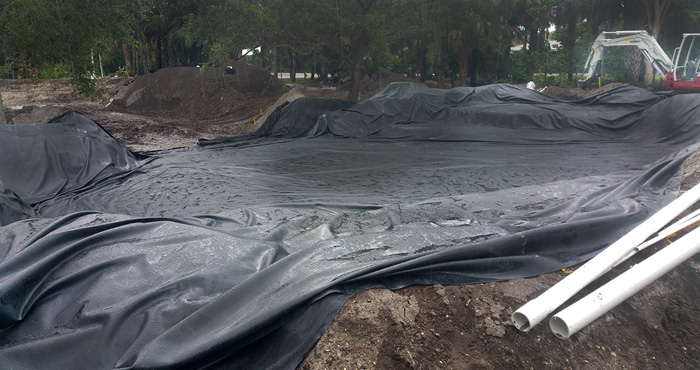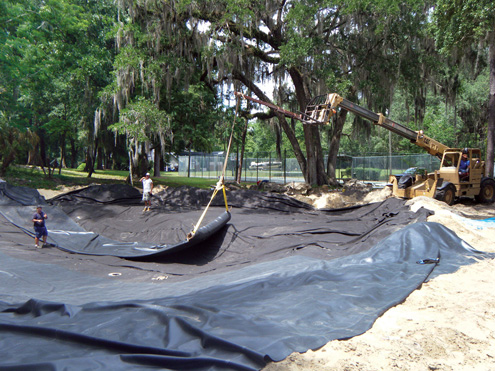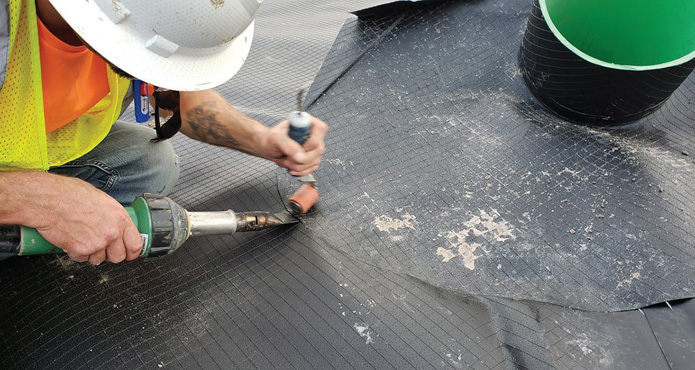
What else can be said about a pond liner, other than it’s just a big panel of rubber membrane included in a pond kit? The answer is … quite a lot. Here’s an introduction to several types of liners and the diversification and growth opportunities they could offer your company.
Though liners are the foundation for most ponds in the decorative pond industry, contractors tend to be most familiar with Ethylene Propylene Diene Monomer (EPDM) liners, as this type is found in probably 99% of pond kits on the market today. Polyvinyl Chloride (PVC), Reinforced Polyethylene (RPE), Low Density Polyethylene (LDPE), High Density Polyethylene (HDPE), Linear Low Density Polyethylene (LLDPE) and many others are available, and each type has its own characteristics, strengths, weaknesses, pros, cons and suitable uses. Some liners can be used in many applications, while others have more limited utility. In this article, I will be “under-lining” the three types of liners most commonly used in small, backyard water gardens and large, acre-plus-sized ponds.
PVC Liners
Many new contractors and DIY homeowners like to reach out and grab some PVC liner at their local home improvement store for their pond project. Some people choose PVC liner because they don’t know there are better options; others do so just because of wide availability and cost savings.
Frankly, I would not recommend that a professional installer use these low-mil PVC liners offered at most home improvement stores. PVC liners of much higher mils are used in many commercial applications, from landfills and chemical containment ponds to agricultural ponds and fire ponds. These higher-mil PVC liners are more puncture resistant than the common EPDM liner. Unfortunately, these better PVC liners are not available at big box stores and must be custom ordered.PVC Liner Advantages
- Available in panels as large as 200,000 square feet
- Fish-safe variants available
- Easy to patch and seam
- Available in higher mil for better project outcomes
- Very flexible
PVC Liner Disadvantages
- Very short lifespan if exposed to UV
- Very low tear strength
- Very low elongation (Tip: Stretch before tearing!)
- Mostly found in lower mil and not recommended for installation by a professional
- More than twice as heavy as RPE
- Should be ballasted for longer lift
PVC liners are very easy to work with and adapt to most shapes and sizes. For professional installations, I highly suggest your residential client be made aware of the better, longer-lasting liners available on the market. PVC liners should always have a geotextile underlayment installed under it. Sometimes it can be added on top before the installation of a ballast — when the liner is installed and then covered with sand or clay to create another level of security and puncture prevention.
EPDM Liners
Ethylene Propylene Diene Monomer liners — Doesn’t that just roll off the tongue? — are the most commonly used liner for water containment on the decorative end of the pond-building spectrum. From small water gardens, waterfalls without ponds, disappearing water features and koi ponds to large, commercial water features and multi-acre ponds, EPDM liners seem to be the go-to liner for both DIYers and professional contractors.

Since I began installing ponds in 1999, I have purchased hundreds of thousands of square feet of EPDM liner. I love EPDM! I haven’t purchased a pond kit in about 10 years, but I would dare to say that 99.9% of all pond kits sold in the United States include EPDM as the liner. It is very easy to work with, conforms to just about any shape and can be seamed into acre-plus sizes. In Florida, EPDM is our go-to liner in 90% of our installations due to our extremely sandy soil conditions. After long periods of rain, you might have shifting ground conditions, and EPDM’s high elasticity rate is ideal for this. Low-mil PVC with very low elasticity would rip right off the bottom drain and skimmer abutment screws once they started shifting around in the sand. Seaming and patching EPDM is pretty easy and very forgiving in comparison to other liners.
EPDM Liner Advantages
- Widely available
- Extremely flexible
- Very high elongation
- Easy to seam & patch
- Fish-safe variants available
- Decent lifespan when exposed to UV
- Accessories available (e.g., pipe boots, unvulcanized tapes)
EPDM Liner Disadvantages
- Much heavier than PVC and RPE
- Low puncture strength
- Limited to 10,000-square-foot panel
PDM does not mean “glued,” as many seem to think. The process is a little more complex, so manufacturers have decided to simplify the description by using terms such as “glue” and “primer.” These glues and primers are actually polymers that crosslink the molecules and create a totally different material that is stronger than the liner on its own. This is why you never see a properly installed liner rip at the seam — the damage always occurs to either side of the seam.
Due to its weight, EPDM can be manufactured in panels as ranging from 10,000 square feet to as large as 150,000 square feet! EPDM is fairly stable when exposed to UV. Unvulcanized EPDM accessories, such as flashing tapes and pipe boots, are also available and can be very handy when sealing around a pipe or making seams in tight corners. Though the technology is evolving and improvements are investigated for all liners, I do not expect EPDM liners to lose their appeal within the decorative pond industry any time soon.
RPE Liners
RPE can exhibit strength of up to 1,250 psi, which is more than double EPDM’s burst strength of less than 600 psi. RPE cannot be seamed with polymers like EPDM. RPE requires special equipment to heat weld. There are also hand welders and automated welders that roll the length of the liner while seaming the panels as it moves along. Test welds from scrap pieces of RPE are performed and tested in a specialized elongation and tear machine prior to welding the actual panels. The results from this machine allow for the adjustment of the temperature and speed of weld to assure a clean, solid weld.

Patching RPE requires a handheld welder and roller. Once a patch is completed, an extrusion welder, or a very large version of a glue gun with a solid rod of RPE, is used to cover the edges of the patch. (Using an extrusion welder is the same principle as using lap sealant on EPDM patches.)
Some RPE liners do not require the use of underlayment, while others do. Due to the weight of RPE, some manufacturers recommend a ballast installation to aid in preventing the infamous “whales” caused by subterranean hydrostatic and gas pressures. The material’s light weight and availability in large panels make lining a one-acre pond possible with just a few men! The cost of RPE is much lower than EPDM; therefore, a larger pond will require less labor and yield a higher profit per square foot.
RPE Liner Advantages
- Low materials cost
- Lower installation labor cost
- Lighter weight than PVC and EPDM per square foot by 50%
- Stronger than PVC and EPDM
- Best UV resistance
- Many manufacturers and variants available
- Available in up to 150,000-square-foot panels
- Great elongation characteristics
RPE Liner Disadvantages
- Requires special heat equipment to seam and weld
- Installation of a ballast is normally recommended
- Pipe boots need to be custom made in the field
Not all liners are the same or intended for the same job. Understanding the different liners available in the industry and how and when to utilize them will allow you to deliver a better project to your client. If you have only installed EPDM liner, I suggest you research and try high-mil PVC liners as well as RPE liners. The more tools you have in your toolbox, the newer, bigger, more unique and way cooler projects your company will have access to!



You shared all the details about PVC, EPDM, and RPE. After reading this article, anyone can easily understand the difference between these liners. I can say that it’s a great article to choosing the right pond liner.
Thanks
I was on the verge of buying an RPE Liner and using Firestone EPDM Pipe Boots for my PVC pipe penetrations when I accidentally learned the two can not go together. Further research confirmed this as being correct. I need to use EPDM with EPDM or RPE with RPE. OOPS, back to the drawing board!!